The private politics of the 2017 Venice Biennale
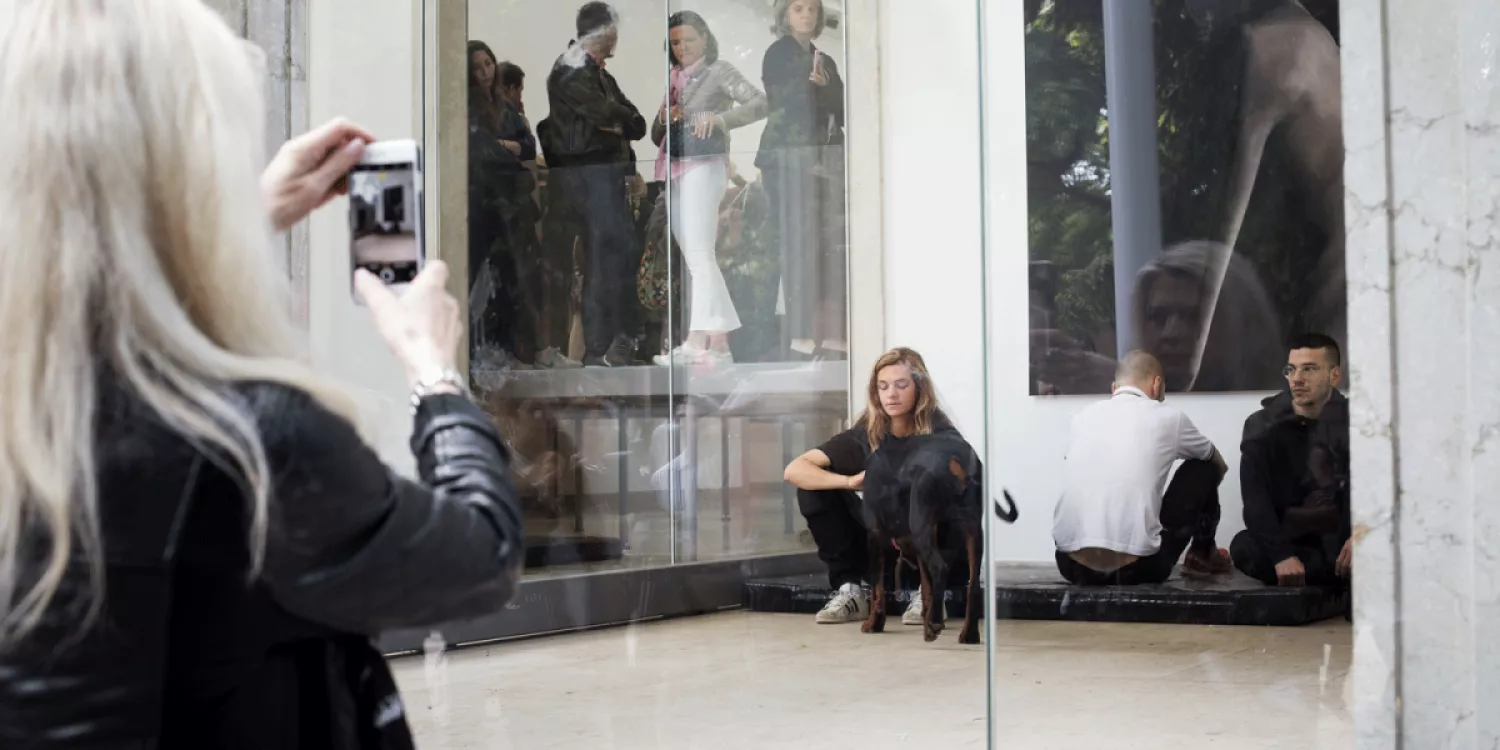
Dobermans, external rage and Alec Baldwin
A performer was sitting inside the fenced garden of the German Pavilion at the Venice Biennial the other day, his emotionless face sniffed by two massive, intimidating Dobermans howling aggressively to anyone daring to come nearby. A moment later, another performer, tall and dressed in all black, climbed to the pavilion’s roof, in the pose of a tragic hero about to jump into the void. Inside, a naked youth laid on his back on the floor, singing a dark song as the audience, standing on a glass platform, recorded the performance with their smartphones. Other figures appeared, human-sculpting struggles between those on top and below, taking turns to dominate one another, mastering and showing submission. The five-hours long durational performance, titled “Faust” (fist in German), has been designed by Anne Imhof, the 39-year-old German artist who has rocked the latest edition of the Biennial (opened to the public this week) where she won the Golden Lion prize for the best pavilion of the year.
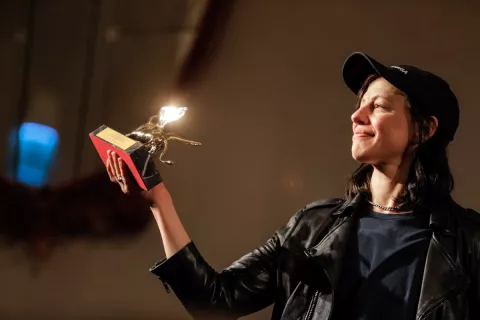
The curator of the main exhibition, Christine Macel, couldn't have given a more kitsch title to the event – “Viva Arte Viva” (loosely translated as long live art). Her cliched slogan repeats itself on thousands of rather unimaginatively-produced posters placed everywhere in town, from Vaporetto stations where they welcome the world‘s art tourists into Venice, to the walls of ancient buildings adjacent to wine bars where curators and critics could be seen sipping overpriced glasses of ice-cold Aperol spritz last week, exhausted by exposure to too much art.
The international press have picked up on the lack of politics in this year’s theme, but in the former Pompidou director’s curatorial statement, Macel stated that she wanted to give prominence to the artists and not the themes. “It is the ideal place for reflection, individual expression, freedom, and fundamental questions. It is a ‘yes’ to life, although sometimes a ‘but’ lies behind. More than ever, the role, the voice and the responsibility of the artist are crucial in the framework of contemporary debates.” This year’s selection of artists is intended to shine a light on neglected practitioners, from a 96-year-old choreographer to an increase in the number of artists from Latin America, the Middle East and Eastern Europe.
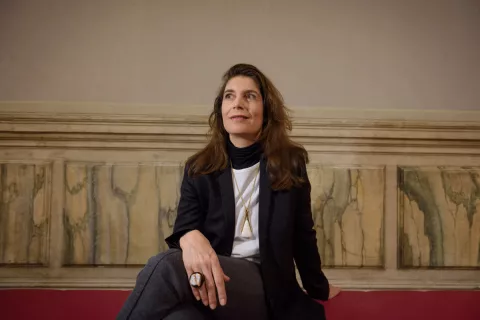
Damien Hirst, David Hockney, Shezad Dawood and Tehching Hsieh all have their own satellite shows (Dawood’s show at Villino Canonico, where he shows the first two episodes of his fascinating film Leviathan, is not to be missed), adding to the anxiety of missing out good art, however hard one tries. The exhibitions seem infinite, the queues never ending, the crowds around the Arsenale coming across art even as they rush from one venue to another. (Noticed the sleeping man lying on the pavement by the bridge? You have just seen “Sleep with Frank Fu”, a performance presented by Hans Ulrich Obrist and Hou Han Ru.)
I found Macel’s main international exhibition at the Giardini more uncontroversial than unpolitical, filled with spaces for artists where, as visitors, we could see them produce art – ateliers, communes, an atmosphere of serene collectivism. All that is meant to turn into a celebration of artistic creativity. Macel, whose love for showing colorful fabrics have a touch of shamanism to it, is a defender of what she calls “neo-humanism” and in a rather old-fashioned way considers art to be the thing the world should seriously focus on in these dark days of global uncertainty – to move beyond the numerous crises and problems.
One such problem, the consistently deceptive leader of the free world, is subtly incorporated into “Tomorrow is another day,” Mark Bradford’s moving show at the US pavilion, in the shape of a massive black and red sculpture that bulges from the ceiling of the entrance room.
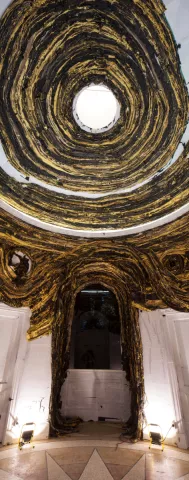
Bradford, the 56-year-old, black, gay Los Angeles artist, has confessed to feeling pushed out of his country in the wake of an increasingly erratic administration that shows a remarkable lack of interest in the issues that really matter to him: the environment and rights of the marginalised. Inside the adjacent gallery, a sculpture reminiscent of Medusa’s hair carries memories of Leimert Park where Bradford in his youth has worked at a hairdresser’s shop with his mother. The artist has called this work an instance of “externalized rage”.
But it’s not all rage in this year’s American pavilion. Bradford has worked with a Venetian nonprofit social cooperative that helps local prisoners reintegrate into society. Together they ran a resource center in the city as an attempt to make a difference for the people of Venice. According to the curator of the show, Christopher Bedford, he has applied “access as a tool for exposing international visitors not only to the current state of the prison system in Italy, but also the success of the social cooperative model.”
Prisons also haunt visitors to the Turkish pavilion this year. Located in Arsenale, the pavilion was transformed into an uncanny space of confinement by sound artist Cevdet Erek, a drummer for Turkish rock band Nekropsi. Choosing to work without a curator, Erek had installed a temporary ramp at the entrance that connects to bleachers and wire fence panels. The feeling is one of walking through the coastline in Venice and ending up on a platform where a sound installation of 35 speakers, the centerpiece of the show, whisper syllables and short phrases in the visitor’s ear, handing out secrets of a nation where people have learned to separate their public identities from private selves in a continuous atmosphere of paranoia in the wake of 2016’s attempted coup.
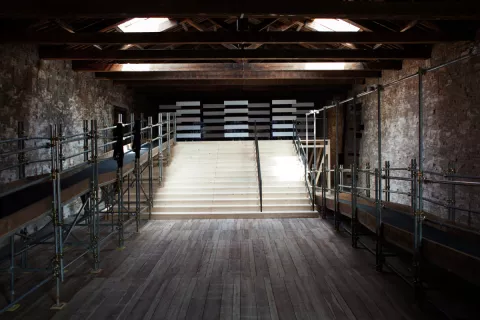
In other pavilions, there were more political escapades, with varying degrees of success. At the South African pavilion, Alec Baldwin and Julianne Moore take it in turns to talk about empathy in Candice Breitz's video installation “Love Story”. Baldwin impersonates someone who lived in Hugo Chavez’s Venezuela, while Moore is a transgender Indian woman. Voicing refugees through two Hollywood A-listers is an interesting but ultimately gimmicky idea. The actors in Moataz Mohamed Nasr Eldin’s multisensory installation “Mountain”, at the Egypt pavilion, couldn’t be more different to Baldwin and Moore. Although they are amateurs there is something genuinely touching in how their characters explore the clash of values in a village whose conservative everyday life is strikingly visualised. Taus Makhacheva’s “Tightrope”, at the main exhibition, explores similar territory: an isolated part of the world, in the Caucasian mountains, where a tightrope walker carries paintings in between mountain peaks, his act of artistic transportation providing a form of defiance against the oppressive Dagestan regime. And at the Korean pavilion, Lee Wan deconstructs various aspects of Korea’s nationalistic history writing through newspaper cuttings and government records.
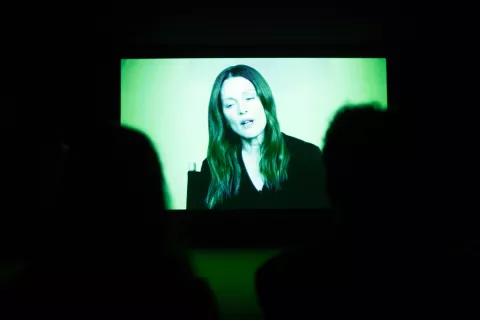
While the international press focused on Macel’s celebration of the art for art’s sake, I suspect this year’s show will be remembered for its immersive investigations into power relations, explorations of the body and the role of technology in our dealings with these phenomena. Susanne Pfeffer, who commissioned Imhof’s work for the German pavilion, has pointed to how Faust’s performers “seem to become drawn towards their own commodification... permanently defying their own objectification.” As I started walking away from watchdogs of the German pavilion on a cloudy but sunny day last week, I thought about my own position as a viewer and about the mass objectification of contemporary art that I have also contributed, having made numerous videos of the performance. How to avoid the pitfall of becoming hunters of Instagram-worthy images in our appreciation of contemporary art? What is the role of the viewer in our interactions with political art? These three impressive pavilions, in their different ways, have unsettled the fetishistic heart of the Biennale, that tired “Viva Arte Viva”.





